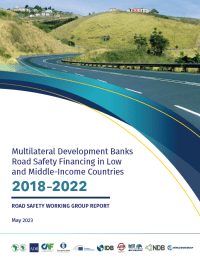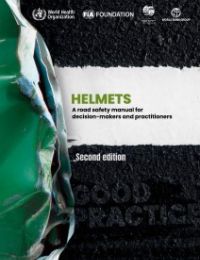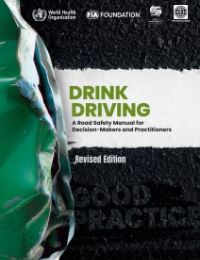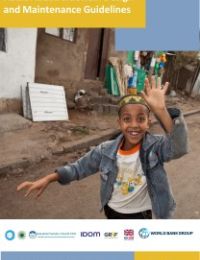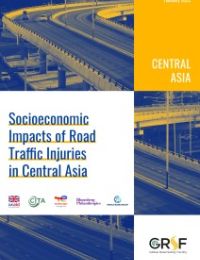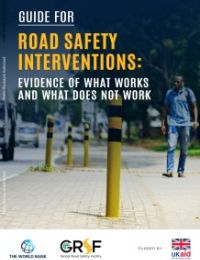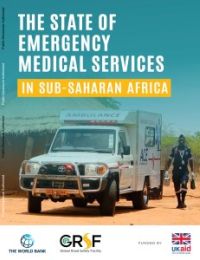Publications
11-20 of 46
-
Economics & Finance
Multilateral Development Banks Road Safety Financing in Low and Middle-Income Countries: 2018–2022
May 2023
-
-
Road Users
Drink-Driving: A Road Safety Manual for Decision-Makers and Practitioners (2nd ed.)
November 2022
-
-
-
- international literature and good practices on motorcycle safety;
- assessment of motorcycle crashes, regulations, risk exposure data, risk indicators in African countries (with more detailed analysis of Burkina Faso, Cameroon, Rwanda, and Uganda); and
- consultations with stakeholders.
-
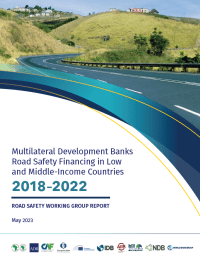
The Multilateral Development Banks (MDBs) Road Safety Working Group, established in 2009, is comprised of ten member institutions that are uniquely positioned to support countries in reaching their considerable and challenging road safety financing needs.
In early 2023, the working group reviewed progress made by the MDBs in financing road safety activities in low and middle-income countries (LMICs), and found that MDBs collectively committed $3.6 billion toward road safety initiatives in developing countries during the period 2018-2022. Three standalone road safety projects—in Bangladesh (World Bank), India (Asian Development Bank and World Bank), and Romania (European Investment Bank)—totaled $912 million in MDBs financing, which is more than one-quarter of the amount committed during this timeframe.
The review is based on details of road and urban mobility project financing provided by seven of the working group's ten members.
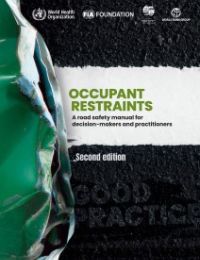
This manual provides guidance and evidence for decision-makers and practitioners that should lead to an increase in the use of vehicle occupant restraints, such as seat-belts for adults and car seats for babies and children. It draws on experience from countries that have succeeded in achieving and sustaining high levels of vehicle occupant restraint use, and builds on new evidence, including from low and middle-income countries.
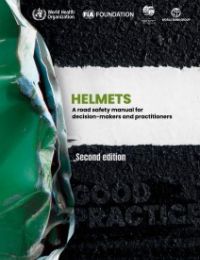
Safe, quality helmets reduce the risk of death in a road crash by over six times, and reduce the risk of brain injury by up to 74%. Head trauma is the leading cause of death for riders, and motorcycles continue to proliferate rapidly. Yet the use of helmets in many low and middle-income countries remains low.
The second edition of the Helmets Manual offers guidance to help decision makers and practitioners put in place the comprehensive set of laws, regulations and actions needed to increase the use of safe, quality helmets to save lives.
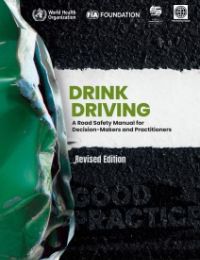
This manual provides guidance for decision-makers and practitioners to reduce the prevalence of drink driving and associated road trauma. It draws on experience from countries that have succeeded in achieving and sustaining reductions in alcohol-related road trauma, and includes recommendations for developing and implementing drink driving legislation, and advice on how to monitor and evaluate progress.
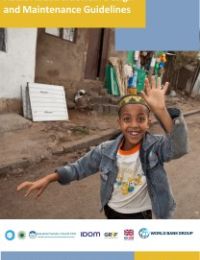
Walking is a predominant mode of travel in Addis Ababa representing more than half of the daily trips. The mild climate in Addis Ababa is conducive for this healthy and green mode of transport. However, sidewalks are often narrow, uneven, obstructed, or non-existent, causing discomfort and road safety risks to the most vulnerable road users: pedestrians. Studies done by the WHO and the Government showed that AA has disproportionately high pedestrian fatalities.
The study on Addis Ababa Sidewalk Safety and Improvement takes the approach of integrating digital technology and Urban Inventory in sidewalk surveys, applies the Global Walkability Index in sidewalk assessments, and adapts the global best practice to the local context. The Addis Ababa Sidewalk Design and Maintenance Guidelines seek to promote the development of quality pedestrian infrastructure and environments, based on the condition’s assessment and global best practices. The design specifications and visual rendering provide recommendations for the policy makers to consider when developing the City’s design and maintenance standards for urban roads, sidewalks, public spaces, and transit-oriented development, some of which are being carried out as part of the technical assistance program of the World-Bank financed Transport Systems Improvement Project (TRANSIP).
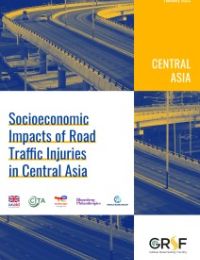
Road traffic injuries (RTIs) are well known to cause enormous human suffering in terms of both morbidity and mortality, and on a global scale. The economic dimension of the disease burden is far less well understood; but it is important to assess the size of the economic burden so that it can be considered when calculating the cost-benefit ratio of policies to tackle this problem. Because it is, in principle, and to some degree, an avoidable one.
This report focuses primarily on assessing various dimensions of the economic consequences of RTIs, as applied specifically to four Central Asian countries (Kazakhstan, Kyrgyzstan, Tajikistan, and Uzbekistan) – a part of the world in which there is still a major need to reduce RTIs.
This study shows that on top of the harm RTIs inflict upon human health, they also impose a considerable financial burden on health care systems. In 2016, the total estimated health costs of RTIs in these four countries was approximately Int$95 million, ranging from Int$2.8million in Tajikistan to Int$49.3 million in Kazakhstan. In Kazakhstan, the overall health costs resulting from RTIs were similar to the cumulative expenditure for rehabilitative and palliative care within the state-guaranteed basic package. The heavy financial burden on health care systems to manage RTIs in these countries adds weight to the urgency to increase preventive efforts by road safety policymakers, and should motivate appropriate organization of the post-crash response by health care system decision makers. The cost estimates discussed in this report indicate the potential for significant economic cost savings if both deaths and injuries from road crashes could be substantially reduced in these countries.

In developing countries with inadequate public transport and road infrastructure, motorcycles present a fast, cheap, and efficient transport alternative. Motorcycles are widely used in many African countries for personal and public transport, as well as for service delivery. In some African countries, motorized two and three-wheelers constitute the largest proportion of the motorized vehicle population. However, despite their benefits, motorcycles expose their riders and passengers to a high risk of serious injury or death in the event of crashes. Motorcycle safety is therefore a significant problem in Africa. On average, 22.5% of road traffic deaths in 2016 involved riders/passengers of two- and three-wheelers, according to the last data published by World Health Organization (WHO, 2018).
This research study presents comprehensive strategic recommendations on how to improve motorcycle safety in Africa. The study will serve as policy advice and technical assistance to the Bank’s regional member countries (RMCs). The study focuses on motorcycle safety conditions in Cameroon, Burkina Faso, Rwanda, and Uganda, where the use of motorcycles for daily activities is reputedly high. Recommendations are predicated on an examination of the major causes of motorcycle crashes and injuries, as well as an extensive body of knowledge from various sources, notably:

Acidentes de trânsito resultam em cerca de 1,35 milhão de mortes e 50 milhões de feridos no mundo todo por ano, com mais de 90% deles ocorrendo em países de renda média e baixa (LMICs). Além da dor e do sofrimento óbvios que isso inflige a indivíduos e comunidades, essas mortes e ferimentos também representam um grande fardo financeiro, especialmente para os LMICs, ao desacelerar o crescimento econômico.
A escala da resposta atual a essa crise contínua não corresponde ao tamanho do problema. Além disso, recursos limitados de segurança no trânsito são frequentemente gastos em intervenções ineficazes ou abaixo do ideal. Embora o conhecimento sobre segurança no trânsito tenha melhorado nas últimas décadas, ainda há necessidade de melhorar a tomada de decisões ao selecionar e aplicar intervenções eficazes de segurança no trânsito baseadas em evidências. Intervenções eficazes são aquelas que reduzem ferimentos fatais e graves.
O Global Road Safety Facility (GRSF) do Banco Mundial desenvolveu este guia baseado em evidências sobre "O que funciona e o que não funciona" na segurança no trânsito em resposta à necessidade crítica de soluções eficazes baseadas em evidências.
Este guia foi preparado para ajudar os leitores a entender que nem todas as intervenções de segurança no trânsito são igualmente eficazes e que o que parecem ser abordagens de "senso comum" para selecionar intervenções de segurança no trânsito muitas vezes não serão as melhores. Embora algumas forneçam benefícios, outras têm impactos muito limitados ou mesmo negativos, apesar de serem comumente — e erroneamente — recomendadas ou aceitas. O guia oferece uma série de recomendações com foco em intervenções em países de baixa e média renda, embora as informações também possam ser relevantes para todos os países. O conteúdo será valioso para aqueles que trabalham com segurança no trânsito em níveis de política ou profissional, incluindo líderes de equipe técnica do Banco Mundial e outros que buscam estabelecer, expandir ou melhorar programas de segurança no trânsito em países de baixa e média renda.
O guia define o conhecimento sobre intervenções baseadas em evidências dentro de um contexto de "Sistema Seguro", fornecendo conselhos sobre cada um dos pilares do Sistema Seguro (gestão de segurança no trânsito, estradas seguras, velocidades seguras, veículos seguros, usuários seguros das estradas e cuidados pós-acidente), ao mesmo tempo em que reconhece que soluções baseadas em evidências devem ser extraídas de todos os pilares para produzir resultados eficazes de segurança no trânsito. No centro deste documento está uma tabela de resumo com uma visão geral de intervenções benéficas e não benéficas com base em evidências científicas sólidas. Isso é seguido por informações mais detalhadas, incluindo estudos de caso e referências à base de evidências para dar suporte ao resumo.
Muitas intervenções rodoviárias seguras são recomendadas para adoção, incluindo transporte público integrado, sistemas de barreiras centrais e de beira de estrada, medianas, infraestrutura para dar suporte à velocidade operacional apropriada para usuários da estrada, rotatórias, separação de nível e intervenções para reduzir a exposição ao risco em cruzamentos, caminhos e travessias de pedestres, instalações separadas para bicicletas e motocicletas e sinais de trânsito e marcação de linhas (incluindo marcação de linhas áudio-táteis). Algumas delas são altamente eficazes, com uma redução de até 70 ou 80 por cento em fatalidades e ferimentos graves (por exemplo, barreiras de segurança e rotatórias).
Várias intervenções relacionadas à velocidade também produzem benefícios significativos, com algumas capazes de quase eliminar mortes e ferimentos graves. Exemplos de intervenções eficazes de velocidade incluem acalmia de tráfego (incluindo lombadas e chicanes), rotatórias, cruzamentos e cruzamentos elevados, tratamentos de entrada, limites de velocidade mais baixos (incluindo zonas de 30 km/h (20 mph) para pedestres) e radares de velocidade.
Uma variedade de intervenções baseadas em usuários de estradas foram implementadas ao longo de muitos anos, com exemplos eficazes incluindo ampla prática supervisionada na estrada e/ou sistemas de licenciamento graduados como parte do sistema de licenciamento de motoristas, aumento da idade para elegibilidade da carteira de motorista, treinamento e teste de percepção de risco, educação pública e campanhas como parte de uma estratégia integrada (especialmente comunicando a fiscalização para aumentar a dissuasão geral), fiscalização, penalidades, bloqueios de álcool, monitoramento de fadiga e velocidade e aumento das taxas de uso de capacetes.
As principais intervenções baseadas em veículos incluem a aplicação de padrões mínimos de segurança de veículos e classificações de veículos (por meio do Global New Car Assessment Program, ou “NCAP”), cintos de segurança, manutenção periódica de veículos, luzes diurnas, protetores contra atropelamento em caminhões, Controle Eletrônico de Estabilidade e outras tecnologias avançadas de veículos.
O atendimento pós-acidente aprimorado também pode produzir melhores resultados de segurança nas estradas, incluindo sistemas para melhorar o tempo de resposta a emergências, melhor atendimento de emergência, melhores habilidades de primeiros socorros para o público e melhor atendimento hospitalar.
Igualmente importante, o relatório também identifica exemplos claros em que as intervenções não são eficazes. As piores são as intervenções que aumentam o risco. Isso inclui aumentar a velocidade de viagem sem melhorar a qualidade da infraestrutura de segurança, a maioria das formas de educação e treinamento de motoristas e passageiros pós-licença e muitas (mas não todas) formas de educação regular de motoristas em escolas (como aquelas que buscam aumentar as habilidades de manuseio de carros). O aumento do risco ocorre normalmente porque tais iniciativas aumentam o nível de confiança, levando a um aumento na tomada de riscos. Outras intervenções que não têm benefícios de segurança demonstrados devem ser evitadas. Isso inclui esquemas de licença por meio de solicitação ou pagamento, programas de treinamento ou educação dentro das escolas que visam melhorar o conhecimento sobre segurança no trânsito (incluindo visitas ad hoc de especialistas ou entusiastas em segurança no trânsito) e campanhas educacionais conduzidas isoladamente.
Existem intervenções alternativas eficazes para cada uma delas, conforme descrito neste documento, e elas devem ser aplicadas em vez disso. É extremamente importante que os recursos não sejam desperdiçados em intervenções ineficazes em nome da segurança no trânsito, mas sim que intervenções de segurança no trânsito baseadas em evidências sejam empregadas.
Há uma variedade de documentos disponíveis sobre a questão da eficácia das intervenções de segurança no trânsito, muitos dos quais são referenciados aqui. No entanto, há alguns pontos-chave de diferenças e valor agregado neste guia, incluindo uma síntese das evidências sobre uma ampla gama de intervenções e um contraste entre intervenções eficazes e não eficazes, permitindo que os leitores comparem as opções. Onde intervenções não efetivas são identificadas, intervenções efetivas viáveis são fornecidas, apoiando assim a tomada de decisões. O guia também fornece aconselhamento direto para aqueles que trabalham em países de baixa e média renda, com base em fontes-chave de informação, onde isso está disponível. É importante ressaltar que evidências concisas, porém robustas, são fornecidas em cada um dos pilares do Sistema Seguro.
Há uma necessidade de continuar construindo a base de conhecimento sobre intervenções efetivas de segurança no trânsito, particularmente em países de baixa e média renda, onde há uma série de lacunas no conhecimento. O conteúdo deste guia representa um resumo útil e atualizado do conhecimento atual para aplicação.
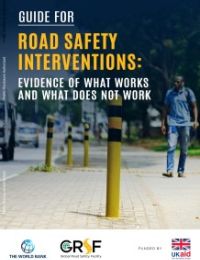
Road traffic crashes result in an estimated 1.35 million deaths and 50 million injuries worldwide per year with over 90 percent of these occurring in Low-Middle Income Countries (LMICs). Aside from the obvious pain and suffering this inflicts on individuals and communities, these deaths and injuries also place a large financial burden particularly on LMICs, by slowing economic growth.
The scale of the current response to this continuing crisis does not match the size of the problem. In addition, limited road safety resources are often expended on ineffective or suboptimal interventions. While road safety knowledge has improved over recent decades, there is still a need to improve decision making when selecting and applying effective evidence-based road safety interventions. Effective interventions are those that reduce fatal and serious injuries.
The World Bank's Global Road Safety Facility (GRSF) has developed this evidence-based guide on “What Works and What Does Not Work” in road safety in response to the critical need for effective evidence-based solutions.
This guide has been prepared to help readers understand that not all road safety interventions are equally effective and that what appear to be “common-sense” approaches to selecting road safety interventions will often not be the best. Although some provide benefits, others have very limited or even negative impacts, despite being commonly—and mistakenly—recommended or accepted. The guide offers a range of recommendations with a focus on interventions in LMICs, although the information may also be of relevance to all countries. The contents will be valuable to those working on road safety at policy or practitioner levels, including World Bank technical team leaders and others who seek to establish, expand, or improve road safety programs in LMICs.
The guide sets knowledge on evidence-based interventions within a “Safe System” context, providing advice on each of the Safe System pillars (road safety management, safe roads, safe speeds, safe vehicles, safe road users, and post-crash care) while recognizing that evidence-based solutions must be drawn from across pillars to produce effective road safety outcomes. At the core of this document is a summary table with an overview of beneficial and non-beneficial interventions based on sound scientific evidence. This is followed by more detailed information including case studies and references to the evidence base to support the summary.
Many safe road interventions are recommended for adoption, including integrated public transport, roadside and central barrier systems, medians, infrastructure to support appropriate operational speed for road users, roundabouts, grade separation and interventions to reduce exposure to risk at intersections, pedestrian footpaths and crossings, separated bicycle and motorcycle facilities, and traffic signs and line marking (including audio-tactile line marking). Some of these are highly effective, with up to a 70 or 80 percent reduction in fatalities and severe injuries (for example, safety barriers and roundabouts).
Various speed-related interventions also produce significant benefits, with some able to almost eliminate death and serious injury. Examples of effective speed interventions include traffic calming (including humps and chicanes), roundabouts, raised intersections and crossings, gateway treatments, lower speed limits (including 30 km/h (20 mph) zones for pedestrians) and speed cameras.
A variety of road user-based interventions have been implemented over many years, with effective examples including extensive supervised on-road practice and/or graduated licensing systems as part of the driver-licensing system, increased age for driving license eligibility, hazard perception training and testing, public education and campaigns as part of an integrated strategy (especially communicating enforcement to increase general deterrence), enforcement, penalties, alcohol interlocks, fatigue and speed monitoring, and increased helmet wearing rates.
Key vehicle-based interventions include applying minimum vehicle safety standards and vehicle ratings (through the Global New Car Assessment Program, or “NCAP”), seat belts, periodic vehicle maintenance, daytime running lights, under-run guards on trucks, Electronic Stability Control, and other advanced vehicle technologies.
Enhanced post-crash care can also produce better road safety outcomes, including systems to improve emergency response time, better emergency care, improved first aid skills for the public, and improved hospital care.
Equally important, the report also identifies clear examples where interventions are not effective. The worst of these are interventions that increase risk. These include increasing travel speed without improving quality of safety infrastructure, most forms of post-license driver and rider education and training, and many (but not all) forms of regular school-based driver education (such as those that seek to increase car-handling skills). The increase in risk is typically because such initiatives increase the level of confidence leading to an increase in risk taking. Other interventions that have no demonstrated safety benefits are to be avoided. These include license schemes through application or payment, training programs or education within schools that aim to improve road safety knowledge (including ad hoc visits by road safety experts or enthusiasts), and education campaigns conducted in isolation.
There are effective alternative interventions for each of these as described within this document, and these should be applied instead. It is extremely important that resources are not wasted on ineffective interventions on behalf of road safety but rather that evidence-based road safety interventions are employed.
There are a variety of documents available on the issue of road safety intervention effectiveness, many of which are referenced here. However, there are some key points of differences and added value in this guide, including a synthesis of the evidence on a broad range of interventions and a contrast between effective and noneffective interventions, allowing readers to compare options. Where noneffective interventions are identified, viable effective interventions are provided thereby supporting decision making. The guide also provides direct advice to those working in LMICs, drawing on key sources of information where this is available. Importantly, concise yet robust evidence is provided across each of the Safe System pillars.
There is a need to continue building the knowledge base on effective road safety interventions, particularly in LMICs where there are a number of gaps in knowledge. The contents of this guide represent a useful, up-to-date summary of current knowledge for application.
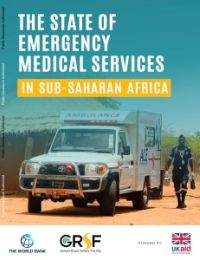
An evaluation of the various Emergency Medical Services (EMS) models and mechanisms in place in Sub-Saharan Africa (SSA) is critical in order to have a better understanding of what can be improved upon for effective pre-hospital and emergency care services (PECS). With grant funding provided by the World Bank’s Global Road Safety Facility (GRSF), this report aims explore the State of EMS Systems in Sub-Saharan Africa through a review of the models and mechanisms being developed across various States.
The premise of the report focuses on the fundamentals for effectively providing satisfactory treatment to those in need of urgent medical care, while also recognizing that there are multiple pathways, framed by the respective legislative, legal and regulatory enabling environments, towards a more formal and sustainable EMS model. It represents an effort to identify the major similarities and differences, as well as potential opportunities for greater coordination or collaboration, that can lead to the development of sound policy recommendations for fostering and expanding post-crash response services in the region.
High-level system information has been collected through questionnaires distributed to National Respondents in each country, for which 25 of 44 countries substantially responded as of April 2019 (collectively hereinafter referred to as SSA countries): Botswana, Burkina Faso, Burundi, Cabo Verde, Cameroon, Central African Republic, Chad, Comoros, Congo Brazzaville, Gabon, Lesotho, Liberia, Madagascar, Malawi, Mauritania, Niger, Rwanda, Senegal, Sierra Leone, Sudan, Tanzania, Togo, Uganda, Zambia and Zimbabwe. Missing data and discrepancies triggered a detailed review of laws and other regulatory acts, policy and plan.
The Report does not consider the advantages and disadvantages for the EMS models adopted by SSA countries, nor does it take a position on which regulatory approach should be applied, or measure the degree of EMS standards implementation and the success or failure of implementing various EMS policies. The principal aim of this report is to capture the current range of the standards and regulations in key areas of EMS systems across SSA.
The State of Emergency Medical Services in Sub-Saharan Africa is supported by UK Aid through the World Bank’s Global Road Safety Facility.

